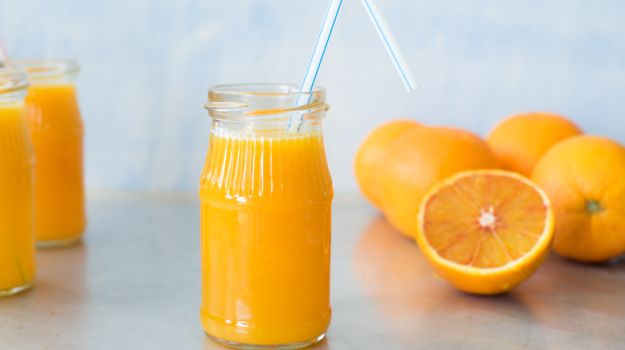Here are 6 amazing Vitamin C benefits for skin and health, from reducing stress to decreasing the severity of common cold. We've also listed the symptoms of Vitamin C deficiency.
Vitamin C, also referred to as 'ascorbic acid', is an important nutrient required by the body. This water-soluble nutrient acts a powerful antioxidant needed for the development and maintenance of arteriole, scar tissues and cartilage.
Certain fruits and vegetable packed with Vitamin C can help us fulfill our daily requirements. These include Kiwi fruit, broccoli, guava, yellow bell peppers, dark green leafy vegetables like spinach, Swiss chard and turnip greens, tomatoes, strawberries and papaya. Delhi-based Nutritionist and Diet Consultant, Nidhi Sawhney explains, "The human body doesn't have the capacity to generate Vitamin C. Therefore, it needs to be received through food and other supplements. It's also important to cook the food at low temperatures and for short time to preserve the Vitamin C content in foods as it is a heat-sensitive nutrient."
What is a Vitamin C deficiency?
Symptoms of a deficiency of Vitamin C includes fatigue, mood changes, weight loss, joint and muscle aches, bruising, dental conditions and dry hair and skin. Over time, a lack of vitamin C in the body means that new collagen cannot be formed. This also causes various tissues in an individual's body to break down and it also affects the repair of cells. Severe deficiency of Vitamin C can lead to a disease called Scurvy.
Benefits of Vitamin C
1. Common Cold
Vitamin C decreases the severity of cold and flu attacks. It lessens the nauseating effects of common cold, including inflammation and a runny nose. It not only controls the allergy that causes cold but also, shortens the duration of cold. It is a known fact that Vitamin C tends to boost your immunity.
2. Hypertension
Incidences of abnormally high blood pressure can be lowered by the regular intake of Vitamin C.
3. Stress
Vitamin C helps a lot in dealing with typical indicators of physical and emotional stress. It also, decreases the level of stress hormones.
4. Fat Metabolism
Stomach fat, or abdominal fat, is fatty tissue around or inside the abdominal cavity. For proper fat metabolism, regular intake of Vitamin C is essential. Vitamin C helps in boosting your metabolism and thus, keeps your weight in check.
5. Collagen Production
Collagen is a substance that is naturally produced by the body. However, the production of this substance diminishes as people grow older. Vitamin C plays an integral part in the production of collagen which therefore decreases wrinkles and also the symptoms and signs of aging.
6. Better Skin
The formation of elastin, a compound which thickens, protects and heals the skin cells, depends on Vitamin C levels in your body. Elastin keeps your skin healthy and glowing.
According to Nutritionist Nidhi Sawhney, "There are many health benefits of Vitamin C. From combating stroke to healing wounds, Vitamin C also helps in the absorption of iron by the body. This is why it's suggested to pair foods full of Vitamin C with iron-rich foods."
read more →
Vitamin C, also referred to as 'ascorbic acid', is an important nutrient required by the body. This water-soluble nutrient acts a powerful antioxidant needed for the development and maintenance of arteriole, scar tissues and cartilage.
Certain fruits and vegetable packed with Vitamin C can help us fulfill our daily requirements. These include Kiwi fruit, broccoli, guava, yellow bell peppers, dark green leafy vegetables like spinach, Swiss chard and turnip greens, tomatoes, strawberries and papaya. Delhi-based Nutritionist and Diet Consultant, Nidhi Sawhney explains, "The human body doesn't have the capacity to generate Vitamin C. Therefore, it needs to be received through food and other supplements. It's also important to cook the food at low temperatures and for short time to preserve the Vitamin C content in foods as it is a heat-sensitive nutrient."
What is a Vitamin C deficiency?
Symptoms of a deficiency of Vitamin C includes fatigue, mood changes, weight loss, joint and muscle aches, bruising, dental conditions and dry hair and skin. Over time, a lack of vitamin C in the body means that new collagen cannot be formed. This also causes various tissues in an individual's body to break down and it also affects the repair of cells. Severe deficiency of Vitamin C can lead to a disease called Scurvy.
Benefits of Vitamin C
1. Common Cold
Vitamin C decreases the severity of cold and flu attacks. It lessens the nauseating effects of common cold, including inflammation and a runny nose. It not only controls the allergy that causes cold but also, shortens the duration of cold. It is a known fact that Vitamin C tends to boost your immunity.
2. Hypertension
Incidences of abnormally high blood pressure can be lowered by the regular intake of Vitamin C.
Vitamin C helps a lot in dealing with typical indicators of physical and emotional stress. It also, decreases the level of stress hormones.
4. Fat Metabolism
Stomach fat, or abdominal fat, is fatty tissue around or inside the abdominal cavity. For proper fat metabolism, regular intake of Vitamin C is essential. Vitamin C helps in boosting your metabolism and thus, keeps your weight in check.
5. Collagen Production
Collagen is a substance that is naturally produced by the body. However, the production of this substance diminishes as people grow older. Vitamin C plays an integral part in the production of collagen which therefore decreases wrinkles and also the symptoms and signs of aging.
6. Better Skin
The formation of elastin, a compound which thickens, protects and heals the skin cells, depends on Vitamin C levels in your body. Elastin keeps your skin healthy and glowing.
According to Nutritionist Nidhi Sawhney, "There are many health benefits of Vitamin C. From combating stroke to healing wounds, Vitamin C also helps in the absorption of iron by the body. This is why it's suggested to pair foods full of Vitamin C with iron-rich foods."







































